Outdoor Thermal Comfort of Urban Park—A Case Study
Abstract
:1. Introduction
- To study the effects of various landscape types of urban parks on human thermal comfort in order to evaluate the landscape types with the best thermal comfort in winter and summer.
- To determine the neutral temperature and neutral temperature range of outdoor thermal comfort in Chengdu and evaluate the applicability of PET and UTCI of outdoor environment in Chengdu.
- To provide a reference level or scope for urban planners and landscape designers.
2. Methodology
2.1. Urban Park Status and Test Sites Layout
2.2. Meteorological Measurement
2.3. Questionnaire Survey
2.4. Thermal Comfort Indices
3. Results
3.1. Experimental Results
3.2. Questionnaire Survey Results
3.3. Effects of Different Landscape Spaces on Human Thermal Comfort
3.3.1. Thermal Sensation Vote
3.3.2. Meteorological Factors Preference Vote
3.3.3. Overall Thermal Comfort Vote (OTC)
3.3.4. Thermal Acceptability Vote (TAV)
3.4. Thermal Indices
3.4.1. Physiological Equivalent Temperature (PET)
3.4.2. Universal Thermal Climate Index (UTCI)
4. Discussion
4.1. Most Comfortable Type of Landscape Space
4.2. Factors Affecting Human Thermal Comfort
4.3. Thermal Indices
4.4. Study Limitations
5. Conclusions
- Different types of landscape spaces have different effects on human thermal comfort, and the same landscape space has different thermal comforts in different seasons. In summer, the thermal comfort ranking for the four sites is Site D (Woods) > Site A (Square) > Site B (Lakeside) > Site C (Lawn); in winter, the thermal comfort ranking for the four sites is Site C (Lawn) > Site B (Lakeside) > Site A (Square)> Site D (Woods).
- Among various meteorological parameters, air temperature is the most important factor affecting outdoor thermal comfort, and the relative humidity has the least impact on thermal comfort. In urban parks, increasing wind speed during the summer and strengthening solar radiation during the winter can effectively improve outdoor thermal comfort. And urban residents in Chengdu are not sensitive to changes in the relative humidity of urban parks, and there is no strong willingness to change relative humidity.
- The overall thermal comfort vote (OTC) and the thermal acceptability vote (TAV) are closely related to the thermal sensation vote (TSV), and the results of the three questions are very similar. The ASHRAE seven-sites scale determines that the thermal sensation is applicable to the Chengdu area.
- The neutral temperatures of PET and UTCI are 12.6 °C and 18.7 °C in winter in Chengdu, respectively, and the neutral temperatures of PET and UTCI are 15.9 °C and 25.5 °C in summer, respectively. The neutral temperature ranges for PET and UTCI are 6.7 °C–18.2 °C and 13.8 °C–23.5 °C in winter, respectively, and the neutral temperature ranges for PET and UTCI are 11.2 °C–20.5 °C and 22.8 °C–28.2 °C in summer, respectively.
- Compare PET and UTCI to determine the accuracy of predicting outdoor thermal comfort for urban residents. The results show that UTCI is a better indicator for evaluating outdoor human thermal comfort in Chengdu.
Author Contributions
Funding
Acknowledgments
Conflicts of Interest
References
- Zhang, X.; Steeneveld, G.; Zhou, D.; Duan, C.; Holtslag, A.A.M. A diagnostic equation for the maximum urban heat island effect of a typical Chinese city: A case study for Xi’an. Build. Environ. 2019, 158, 39–50. [Google Scholar] [CrossRef]
- Liu, L.; Lin, Y.; Liu, J.; Wang, L.; Wang, D.; Shui, T.; Chen, X.; Wu, Q. Analysis of local-scale urban heat island characteristics using an integrated method of mobile measurement and GIS-based spatial interpolation. Build. Environ. 2017, 117, 191–207. [Google Scholar] [CrossRef]
- Xiong, J.; Lian, Z.; Zhou, X. Investigation of Subjectively Assessed Health Symptoms and Human Thermal Perceptions in Transient Thermal Environments. Procedia Eng. 2015, 121, 212–216. [Google Scholar] [CrossRef] [Green Version]
- Wang, Y.; Wang, A.; Zhai, J.; Tao, H.; Jiang, T.; Su, B.; Yang, J.; Wang, G.; Liu, Q.; Gao, C.; et al. Tens of thousands additional deaths annually in cities of China between 1.5 °C and 2.0 °C warming. Nat. Commun. 2019, 10, 3376–3377. [Google Scholar] [CrossRef]
- Lai, D.; Zhou, C.; Huang, J.; Jiang, Y.; Long, Z.; Chen, Q. Outdoor space quality: A field study in an urban residential community in central China. Energy Build. 2014, 68, 713–720. [Google Scholar] [CrossRef]
- Ashare Standard 55-2017. Thermal Enviromentla Conditions for Human Occupancy; American Society of Heating, Refrigerating and Air-Conditioning Engineers: Atlanta, GA, USA, 2017. [Google Scholar]
- Morakinyo, T.E.; Lam, Y.F.N. Simulation study on the impact of tree-configuration, planting pattern and wind condition on street-canyon’s micro-climate and thermal comfort. Build. Environ. 2016, 103, 262–275. [Google Scholar] [CrossRef]
- Morakinyo, T.E.; Lau, K.K.-L.; Ren, C.; Ng, E. Performance of Hong Kong’s common trees species for outdoor temperature regulation, thermal comfort and energy saving. Build. Environ. 2018, 137, 157–170. [Google Scholar] [CrossRef]
- Sun, S.; Xu, X.; Lao, Z.; Liu, W.; Li, Z.; García, E.H.; He, L.; Zhu, J. Evaluating the impact of urban green space and landscape design parameters on thermal comfort in hot summer by numerical simulation. Build. Environ. 2017, 123, 277–288. [Google Scholar] [CrossRef]
- Xi, T.; Li, Q.; Mochida, A.; Meng, Q. Study on the outdoor thermal environment and thermal comfort around campus clusters in subtropical urban areas. Build. Environ. 2012, 52, 162–170. [Google Scholar] [CrossRef]
- Lai, D.; Guo, D.; Hou, Y.; Lin, C.; Chen, Q. Studies of outdoor thermal comfort in northern China. Build. Environ. 2014, 77, 110–118. [Google Scholar] [CrossRef]
- Niu, J.; Liu, J.; Lee, T.-C.; Lin, Z.; Mak, C.M.; Tse, K.-T.; Tang, B.-S.; Kwok, K. A new method to assess spatial variations of outdoor thermal comfort: Onsite monitoring results and implications for precinct planning. Build. Environ. 2015, 91, 263–270. [Google Scholar] [CrossRef] [Green Version]
- Nikolopoulou, M.; Baker, N.; Steemers, K. Thermal comfort in outdoor urban spaces: Understanding the human parameter. Sol. Energy 2001, 70, 227–235. [Google Scholar] [CrossRef]
- Nikolopoulou, M.; Lykoudis, S. Thermal comfort in outdoor urban spaces: Analysis across different European countries. Build. Environ. 2006, 41, 1455–1470. [Google Scholar] [CrossRef] [Green Version]
- Pantavou, K.; Lykoudis, S.; Nikolopoulou, M.; Tsiros, I.X. Thermal sensation and climate: A comparison of UTCI and PET thresholds in different climates. Int. J. Biometeorol. 2018, 62, 1695–1708. [Google Scholar] [CrossRef] [PubMed]
- Sharifi, E.; Boland, J. Passive activity observation (PAO) method to estimate outdoor thermal adaptation in public space: Case studies in Australian cities. Int. J. Biometeorol. 2018, 64, 231–242. [Google Scholar] [CrossRef] [PubMed]
- Johansson, E.; Yahia, M.W.; Arroyo, I.; Bengs, C. Outdoor thermal comfort in public space in warm-humid Guayaquil, Ecuador. Int. J. Biometeorol. 2017, 62, 387–399. [Google Scholar] [CrossRef] [Green Version]
- Lam, C.K.C.; Loughnan, M.; Tapper, N. Visitors’ perception of thermal comfort during extreme heat events at the Royal Botanic Garden Melbourne. Int. J. Biometeorol. 2016, 62, 97–112. [Google Scholar] [CrossRef]
- Hirashima, S.Q.D.S.; Katzschner, A.; Ferreira, D.; De Assis, E.S.; Katzschner, L. Thermal comfort comparison and evaluation in different climates. Urban Clim. 2018, 23, 219–230. [Google Scholar] [CrossRef]
- Ali, S.B.; Patnaik, S. Thermal comfort in urban open spaces: Objective assessment and subjective perception study in tropical city of Bhopal, India. Urban Clim. 2018, 24, 954–967. [Google Scholar] [CrossRef]
- Taleghani, M. The impact of increasing urban surface albedo on outdoor summer thermal comfort within a university campus. Urban Clim. 2018, 24, 175–184. [Google Scholar] [CrossRef]
- Zhang, A.; Bokel, R.; Dobbelsteen, A.V.D.; Sun, Y.; Huang, Q.; Zhang, Q. An integrated school and schoolyard design method for summer thermal comfort and energy efficiency in Northern China. Build. Environ. 2017, 124, 369–387. [Google Scholar] [CrossRef]
- Yahia, M.; Johansson, E.; Thorsson, S.; Lindberg, F.; Rasmussen, M.I. Effect of urban design on microclimate and thermal comfort outdoors in warm-humid Dar es Salaam, Tanzania. Int. J. Biometeorol. 2017, 62, 373–385. [Google Scholar] [CrossRef] [PubMed] [Green Version]
- Zölch, T.; Rahman, M.A.; Pfleiderer, E.; Wagner, G.; Pauleit, S. Designing public squares with green infrastructure to optimize human thermal comfort. Build. Environ. 2019, 149, 640–654. [Google Scholar] [CrossRef]
- Nazarian, N.; Acero, J.A.; Norford, L.K. Outdoor thermal comfort autonomy: Performance metrics for climate-conscious urban design. Build. Environ. 2019, 155, 145–160. [Google Scholar] [CrossRef]
- Lam, J.C.; Yang, L.; Liu, J. Development of passive design zones in China using bioclimatic approach. Energy Convers. Manag. 2006, 47, 746–762. [Google Scholar] [CrossRef]
- GB 50176-2016. Code for Thermal Design of Civil Building; China Architecture & Building Press: Beijing, China, 2016. (In Chinese) [Google Scholar]
- Li, K.; Zhang, Y.; Zhao, L. Outdoor thermal comfort and activities in the urban residential community in a humid subtropical area of China. Energy Build. 2016, 133, 498–511. [Google Scholar] [CrossRef]
- Zhao, L.; Zhou, X.; Li, L.; He, S.; Chen, R. Study on outdoor thermal comfort on a campus in a subtropical urban area in summer. Sustain. Cities Soc. 2016, 22, 164–170. [Google Scholar] [CrossRef]
- Huang, T.; Li, J.; Xie, Y.; Niu, J.; Mak, C.M. Simultaneous environmental parameter monitoring and human subject survey regarding outdoor thermal comfort and its modelling. Build. Environ. 2017, 125, 502–514. [Google Scholar] [CrossRef]
- Li, J.; Niu, J.; Mak, C.M.; Huang, T.; Xie, Y. Assessment of outdoor thermal comfort in Hong Kong based on the individual desirability and acceptability of sun and wind conditions. Build. Environ. 2018, 145, 50–61. [Google Scholar] [CrossRef]
- Chen, X.; Xue, P.; Liu, L.; Gao, L.; Liu, J. Outdoor thermal comfort and adaptation in severe cold area: A longitudinal survey in Harbin, China. Build. Environ. 2018, 143, 548–560. [Google Scholar] [CrossRef]
- Xu, M.; Hong, B.; Mi, J.; Yan, S. Outdoor thermal comfort in an urban park during winter in cold regions of China. Sustain. Cities Soc. 2018, 43, 208–220. [Google Scholar] [CrossRef]
- Xu, M.; Hong, B.; Jiang, R.; An, L.; Zhang, T. Outdoor thermal comfort of shaded spaces in an urban park in the cold region of China. Build. Environ. 2019, 155, 408–420. [Google Scholar] [CrossRef]
- Cheung, P.K.; Jim, C. Comparing the cooling effects of a tree and a concrete shelter using PET and UTCI. Build. Environ. 2018, 130, 49–61. [Google Scholar] [CrossRef]
- Fang, Z.; Feng, X.; Liu, J.; Lin, Z.; Mak, C.M.; Niu, J.; Tse, K.-T.; Xu, X. Investigation into the differences among several outdoor thermal comfort indices against field survey in subtropics. Sustain. Cities Soc. 2019, 44, 676–690. [Google Scholar] [CrossRef]
- Fang, Z.; Feng, X.; Xu, X.; Zhou, X.; Lin, Z.; Ji, Y. Investigation into outdoor thermal comfort conditions by different seasonal field surveys in China, Guangzhou. Int. J. Biometeorol. 2019, 63, 1357–1368. [Google Scholar] [CrossRef] [PubMed]
- Shang, C.; Huang, X.; Zhang, Y.; Chen, M. Outdoor thermal comfort in a tropical coastal tourist resort in Haikou, China. Indoor Built Environ. 2019. [Google Scholar] [CrossRef]
- Cheung, P.K.; Jim, C. Improved assessment of outdoor thermal comfort: 1-hour acceptable temperature range. Build. Environ. 2019, 151, 303–317. [Google Scholar] [CrossRef]
- Yang, B.; Olofsson, T.; Nair, G.; Kabanshi, A. Outdoor thermal comfort under subarctic climate of north Sweden—A pilot study in Umeå. Sustain. Cities Soc. 2017, 28, 387–397. [Google Scholar] [CrossRef]
- Chen, L.; Wen, Y.; Zhang, L.; Xiang, W.-N. Studies of thermal comfort and space use in an urban park square in cool and cold seasons in Shanghai. Build. Environ. 2015, 94, 644–653. [Google Scholar] [CrossRef]
- Ma, X.; Fukuda, H.; Zhou, D.; Gao, W.; Wang, M. The study on outdoor pedestrian thermal comfort in blocks: A case study of the Dao He Old Block in hot-summer and cold-winter area of southern China. Sol. Energy 2019, 179, 210–225. [Google Scholar] [CrossRef]
- Xu, X.; Sun, S.; Liu, W.; García, E.H.; He, L.; Cai, Q.; Xu, S.; Wang, J.; Zhu, J. The cooling and energy saving effect of landscape design parameters of urban park in summer: A case of Beijing, China. Energy Build. 2017, 149, 91–100. [Google Scholar] [CrossRef]
- Klemm, W.; Heusinkveld, B.G.; Lenzholzer, S.; Van Hove, B. Street greenery and its physical and psychological impact on thermal comfort. Landsc. Urban Plan. 2015, 138, 87–98. [Google Scholar] [CrossRef]
- Mahmoud, A. Analysis of the microclimatic and human comfort conditions in an urban park in hot and arid regions. Build. Environ. 2011, 46, 2641–2656. [Google Scholar] [CrossRef]
- Lin, T.-P.; De Dear, R.; Hwang, R.-L. Effect of thermal adaptation on seasonal outdoor thermal comfort. Int. J. Clim. 2011, 31, 302–312. [Google Scholar] [CrossRef]
- Ng, E.; Cheng, V. Urban human thermal comfort in hot and humid Hong Kong. Energy Build. 2012, 55, 51–65. [Google Scholar] [CrossRef]
- He, X.; Miao, S.; Shen, S.; Li, J.; Zhang, B.; Zhang, Z.; Chen, X. Influence of sky view factor on outdoor thermal environment and physiological equivalent temperature. Int. J. Biometeorol. 2014, 59, 285–297. [Google Scholar] [CrossRef]
- Huang, J.; Zhou, C.; Zhuo, Y.; Xu, L.; Jiang, Y. Outdoor thermal environments and activities in open space: An experiment study in humid subtropical climates. Build. Environ. 2016, 103, 238–249. [Google Scholar] [CrossRef] [Green Version]
- Zeng, Y.; Dong, L. Thermal human biometeorological conditions and subjective thermal sensation in pedestrian streets in Chengdu, China. Int. J. Biometeorol. 2014, 59, 99–108. [Google Scholar] [CrossRef]
- Liu, W.; Zhang, Y.; Deng, Q. The effects of urban microclimate on outdoor thermal sensation and neutral temperature in hot-summer and cold-winter climate. Energy Build. 2016, 128, 190–197. [Google Scholar] [CrossRef]
- Cao, B.; Luo, M.; Li, M.; Zhu, Y. Thermal comfort in semi-outdoor spaces within an office building in Shenzhen: A case study in a hot climate region of China. Indoor Built Environ. 2017, 27, 1431–1444. [Google Scholar] [CrossRef]
- Yao, J.; Yang, F.; Zhuang, Z.; Shao, Y.; Yuan, P.F. The effect of personal and microclimatic variables on outdoor thermal comfort: A field study in a cold season in Lujiazui CBD, Shanghai. Sustain. Cities Soc. 2018, 39, 181–188. [Google Scholar] [CrossRef]
- Du, Y.; Mak, C.M.; Huang, T.; Niu, J. Towards an integrated method to assess effects of lift-up design on outdoor thermal comfort in Hong Kong. Build. Environ. 2017, 125, 261–272. [Google Scholar] [CrossRef]
- Fang, Z.; Lin, Z.; Mak, C.M.; Niu, J.; Tse, K.-T. Investigation into sensitivities of factors in outdoor thermal comfort indices. Build. Environ. 2018, 128, 129–142. [Google Scholar] [CrossRef]
- Ma, X.; Fukuda, H.; Zhou, D.; Wang, M. Study on outdoor thermal comfort of the commercial pedestrian block in hot-summer and cold-winter region of southern China-a case study of The Taizhou Old Block. Tour. Manag. 2019, 75, 186–205. [Google Scholar] [CrossRef]
- Ma, X.; Fukuda, H.; Zhou, D.; Wang, M. The Evaluation of Outdoor Thermal Sensation and Outdoor Energy Efficiency of a Commercial Pedestrianized Zone. Energies 2019, 12, 1324. [Google Scholar] [CrossRef] [Green Version]
- Ma, X.; Fukuda, H.; Zhou, D.; Wang, M. A Study of the Pedestrianized Zone for Tourists: Urban Design Effects on Humans’ Thermal Comfort in Fo Shan City, Southern China. Sustainability 2019, 11, 2774. [Google Scholar] [CrossRef] [Green Version]
- Wang, Y.; Ni, Z.; Peng, Y.; Xia, B. Local variation of outdoor thermal comfort in different urban green spaces in Guangzhou, a subtropical city in South China. Urban For. Urban Green. 2018, 32, 99–112. [Google Scholar] [CrossRef]
- Yin, S.; Lang, W.; Xiao, Y.; Xu, Z. Correlative Impact of Shading Strategies and Configurations Design on Pedestrian-Level Thermal Comfort in Traditional Shophouse Neighbourhoods, Southern China. Sustainability 2019, 11, 1355. [Google Scholar] [CrossRef] [Green Version]
- Cheung, P.K.; Jim, C. Subjective outdoor thermal comfort and urban green space usage in humid-subtropical Hong Kong. Energy Build. 2018, 173, 150–162. [Google Scholar] [CrossRef]
- Cheng, B.; Gou, Z.; Zhang, F.; Feng, Q.; Huang, Z. Thermal comfort in urban mountain parks in the hot summer and cold winter climate. Sustain. Cities Soc. 2019, 51. [Google Scholar] [CrossRef]
- National Meteorological Information Centre. 1981–2010. Available online: http://data.cma.cn (accessed on 23 August 2019).
- Matzarakis, A.; Rutz, F.; Mayer, H. Modelling radiation fluxes in simple and complex environments—Application of the RayMan model. Int. J. Biometeorol. 2006, 51, 323–334. [Google Scholar] [CrossRef] [PubMed]
- Matzarakis, A.; Rutz, F.; Mayer, H. Modelling radiation fluxes in simple and complex environments: Basics of the RayMan model. Int. J. Biometeorol. 2009, 54, 131–139. [Google Scholar] [CrossRef] [PubMed] [Green Version]
- Bröde, P.; Fiala, D.; Blazejczyk, K.; Holmér, I.; Jendritzky, G.; Kampmann, B.; Tinz, B.; Havenith, G. Deriving the operational procedure for the Universal Thermal Climate Index (UTCI). Int. J. Biometeorol. 2011, 56, 481–494. [Google Scholar] [CrossRef] [PubMed] [Green Version]
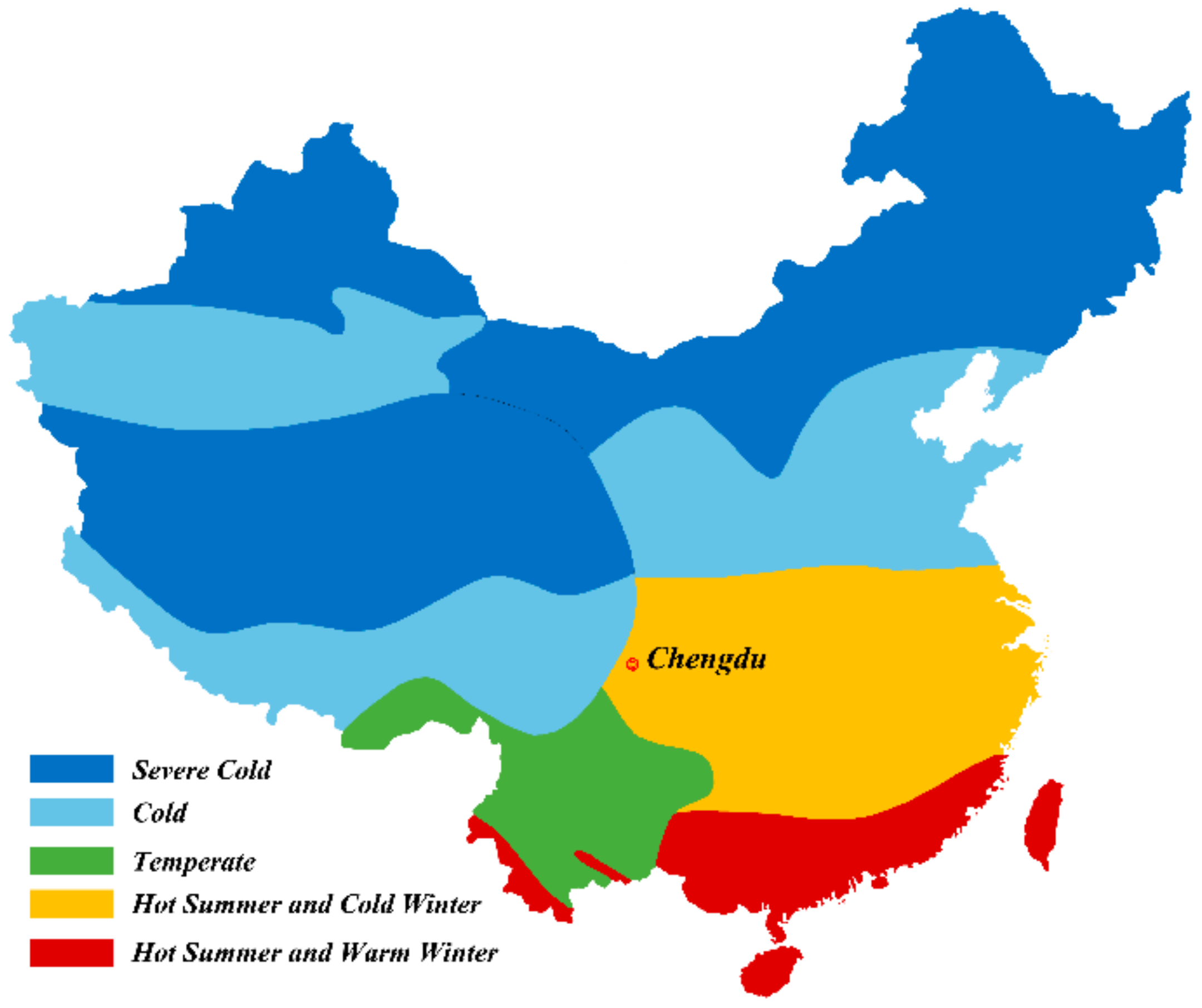
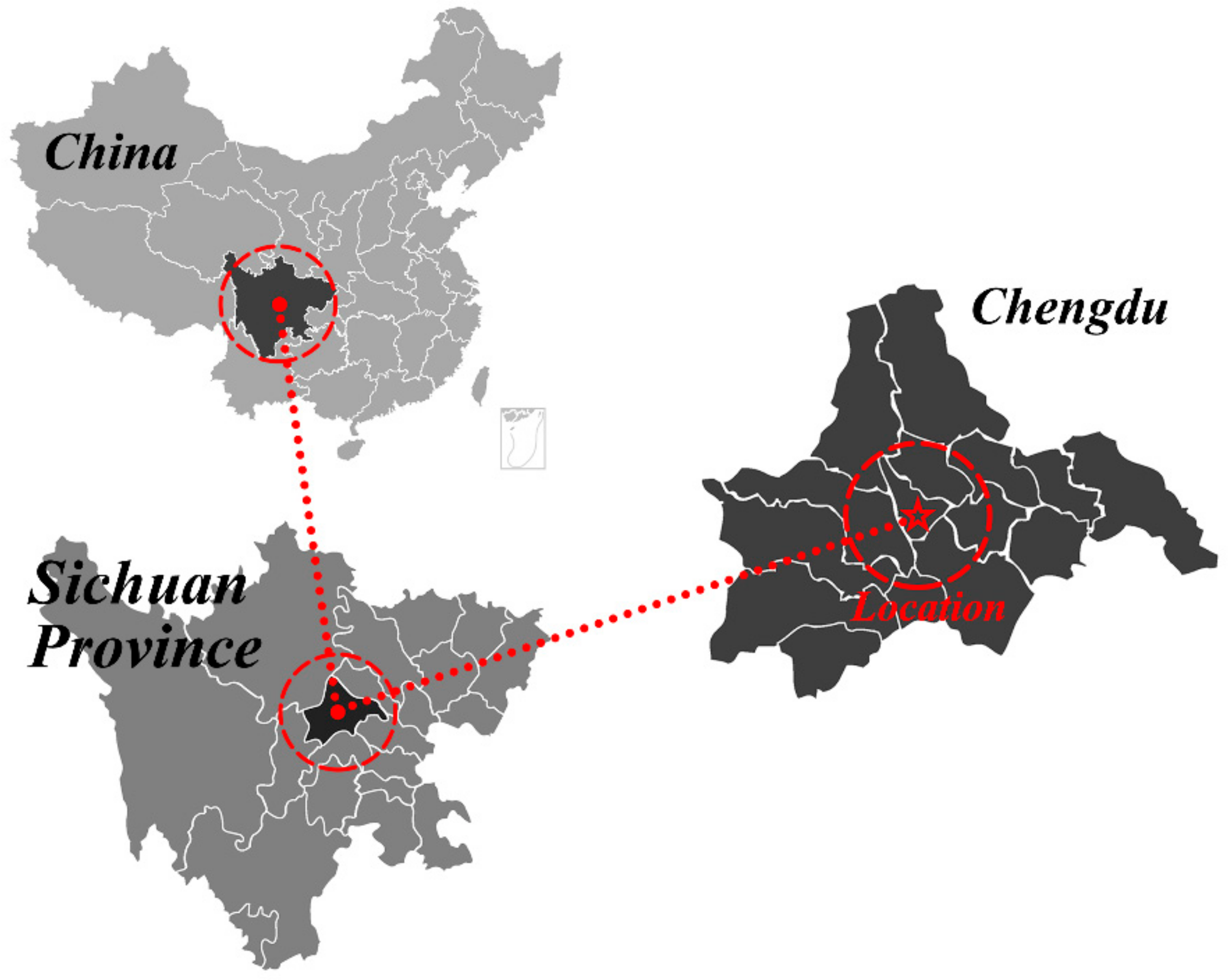
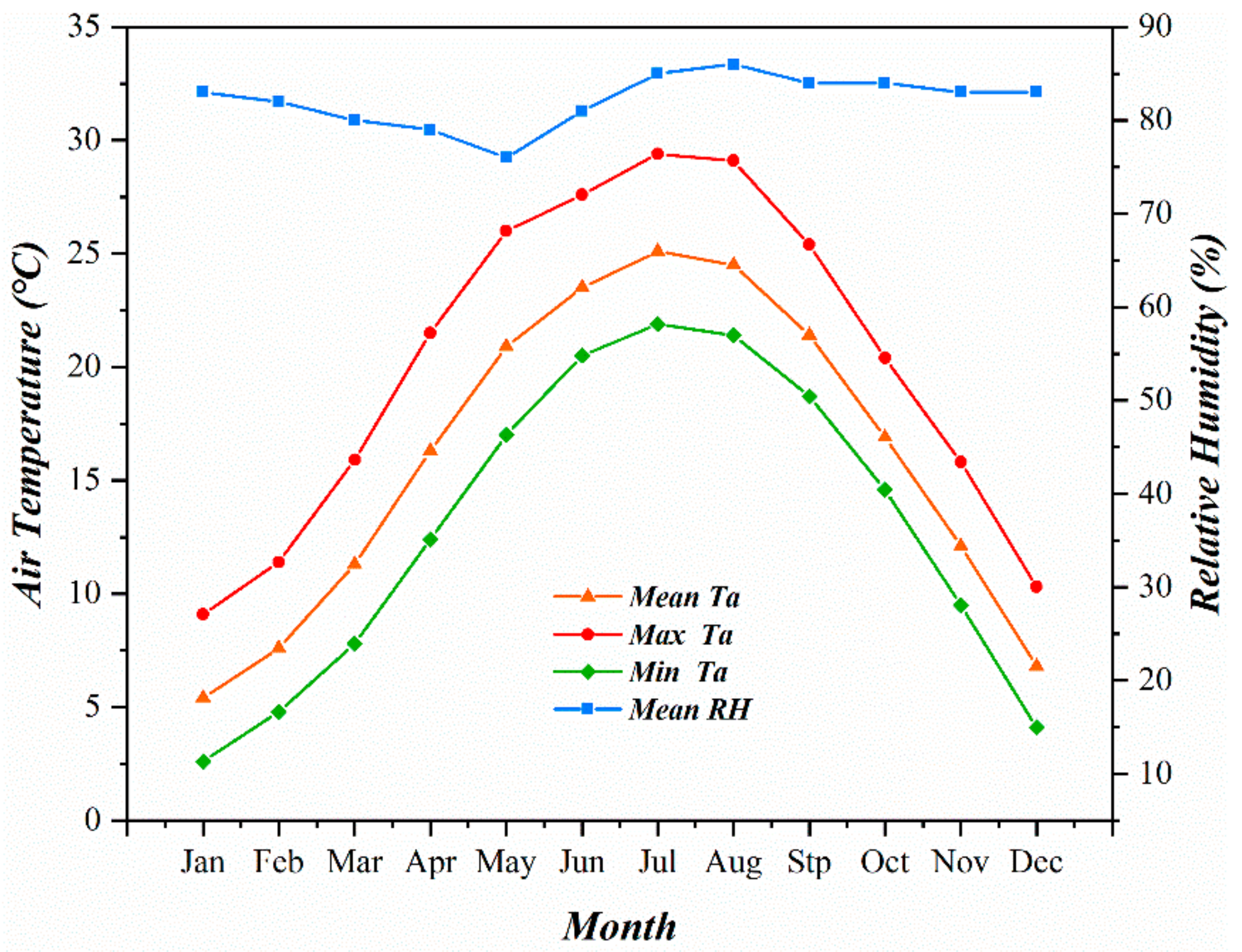

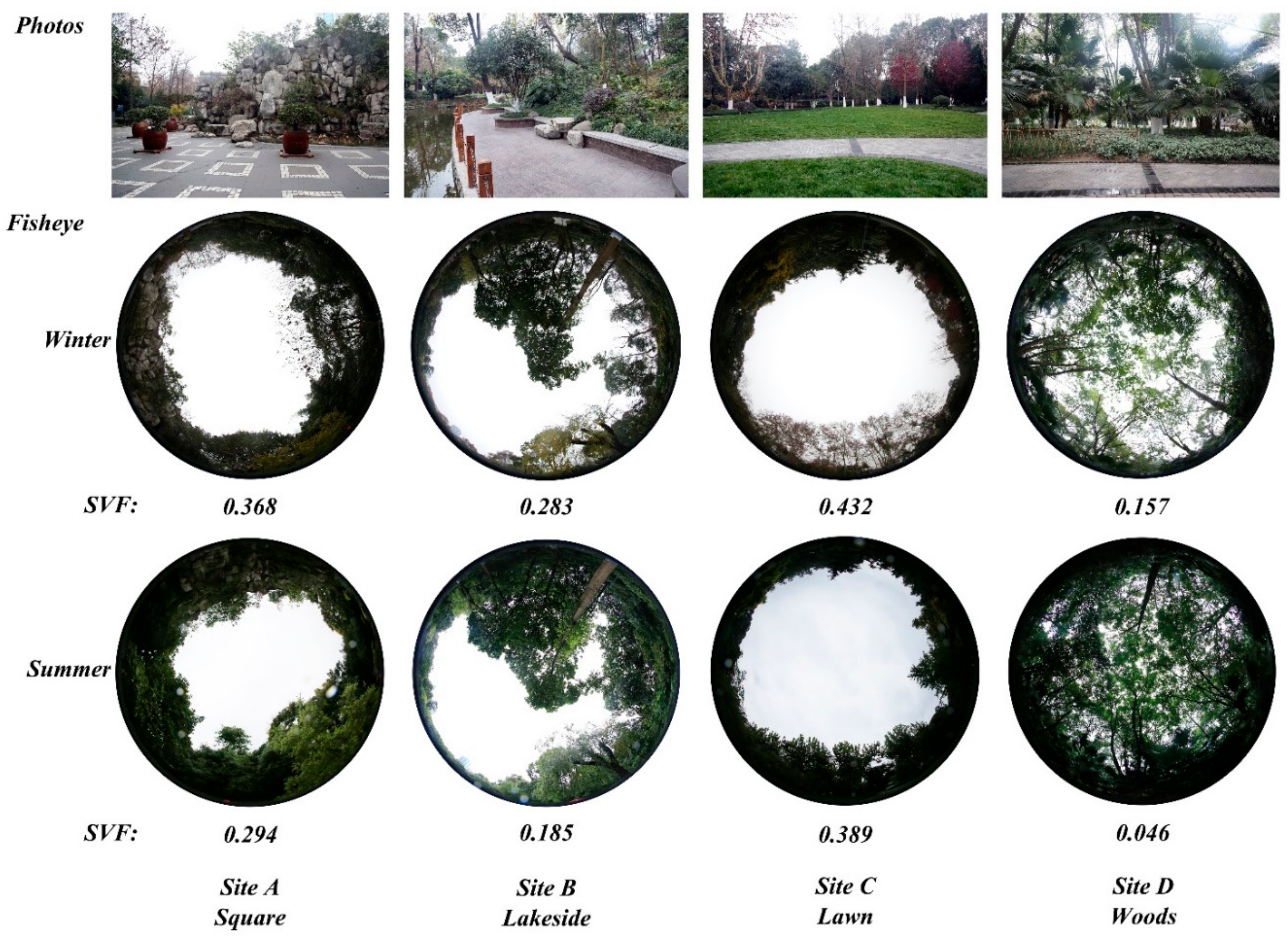
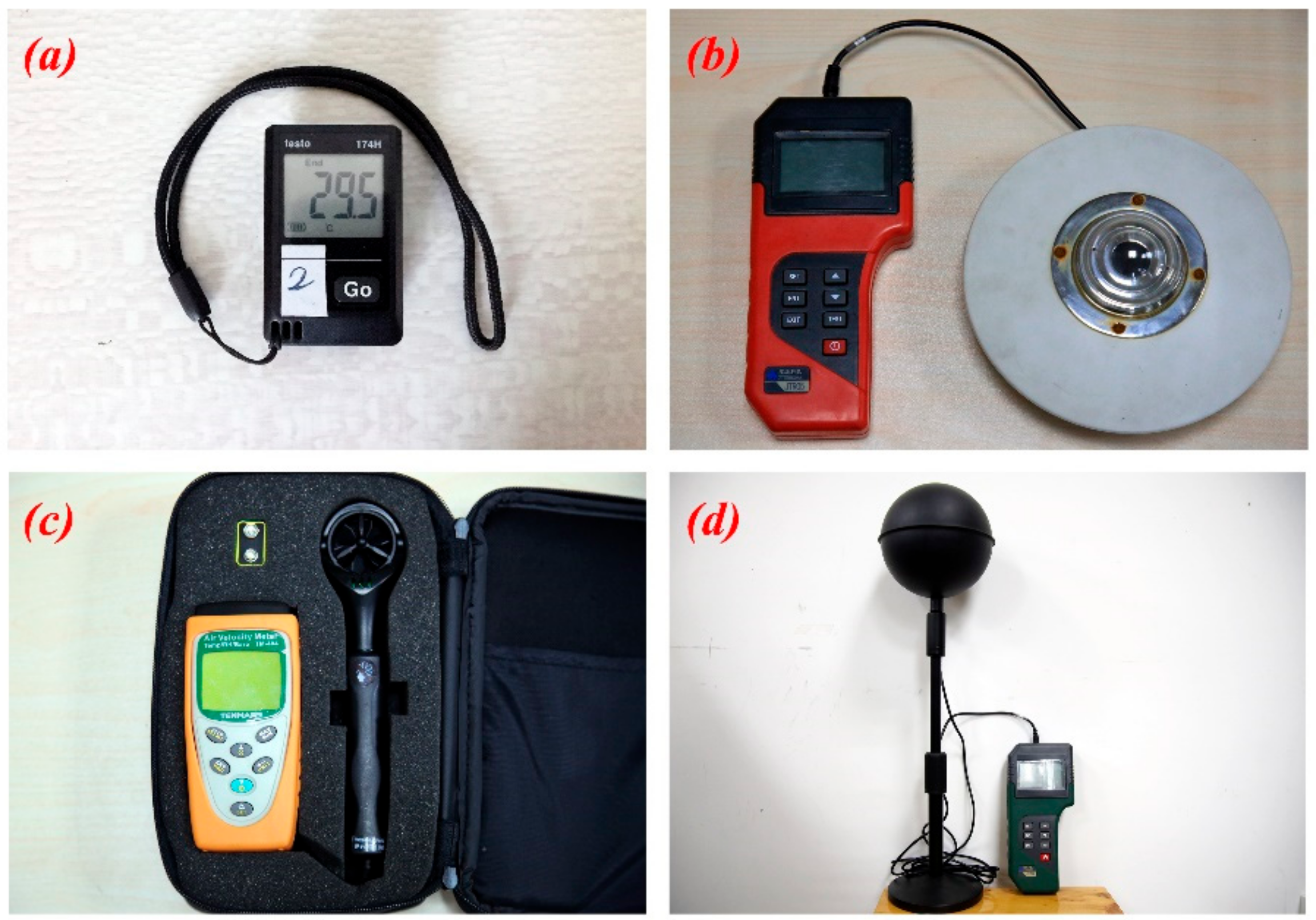
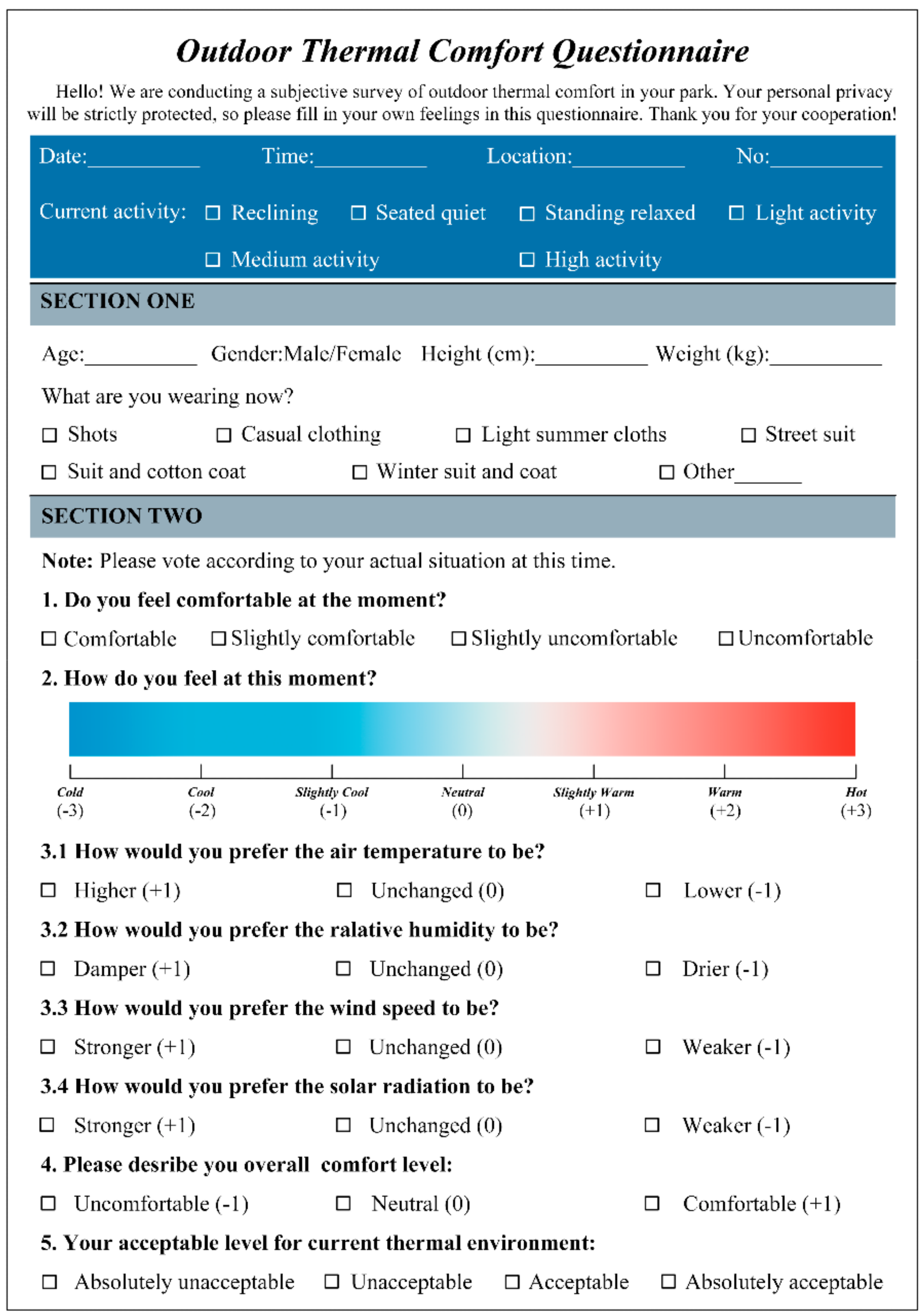

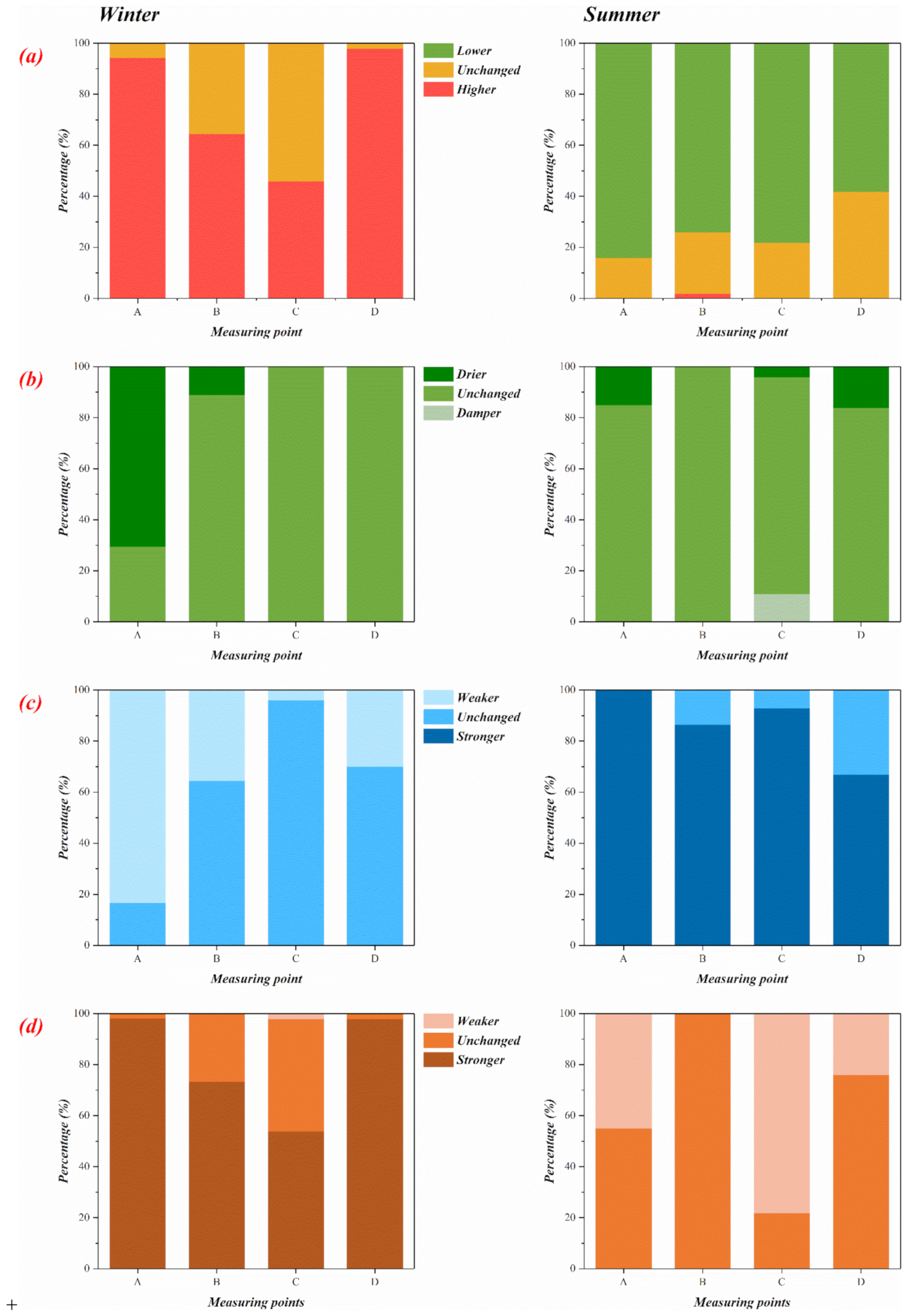
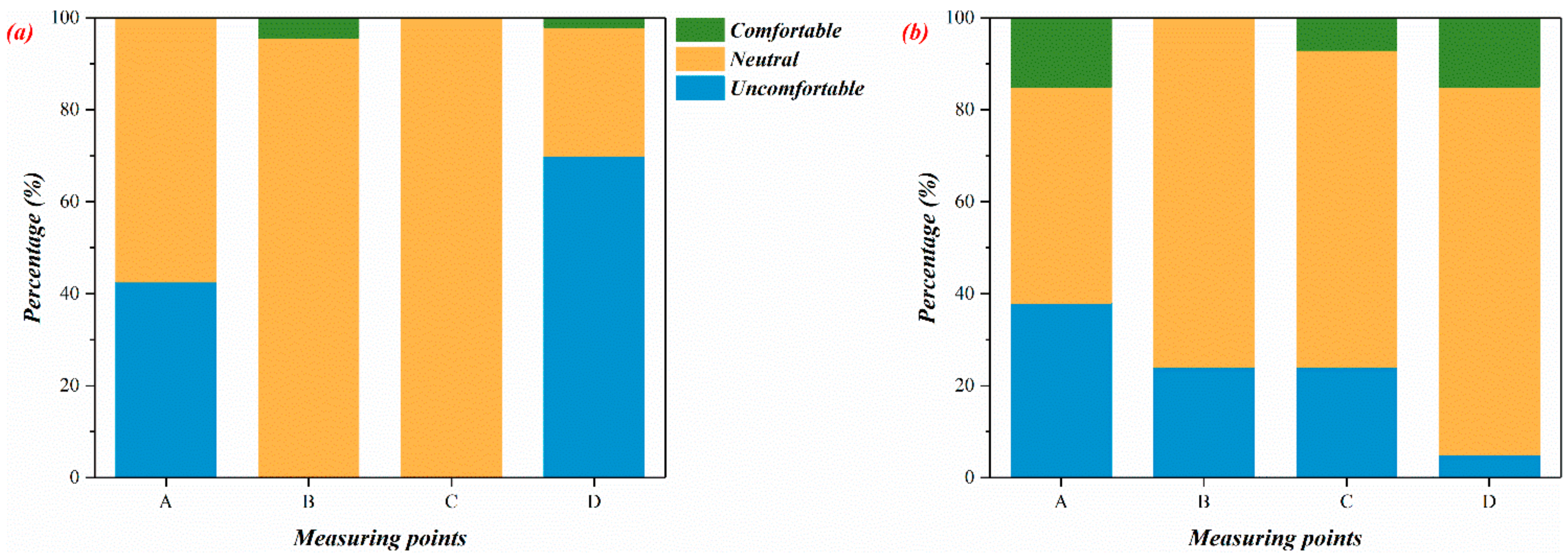

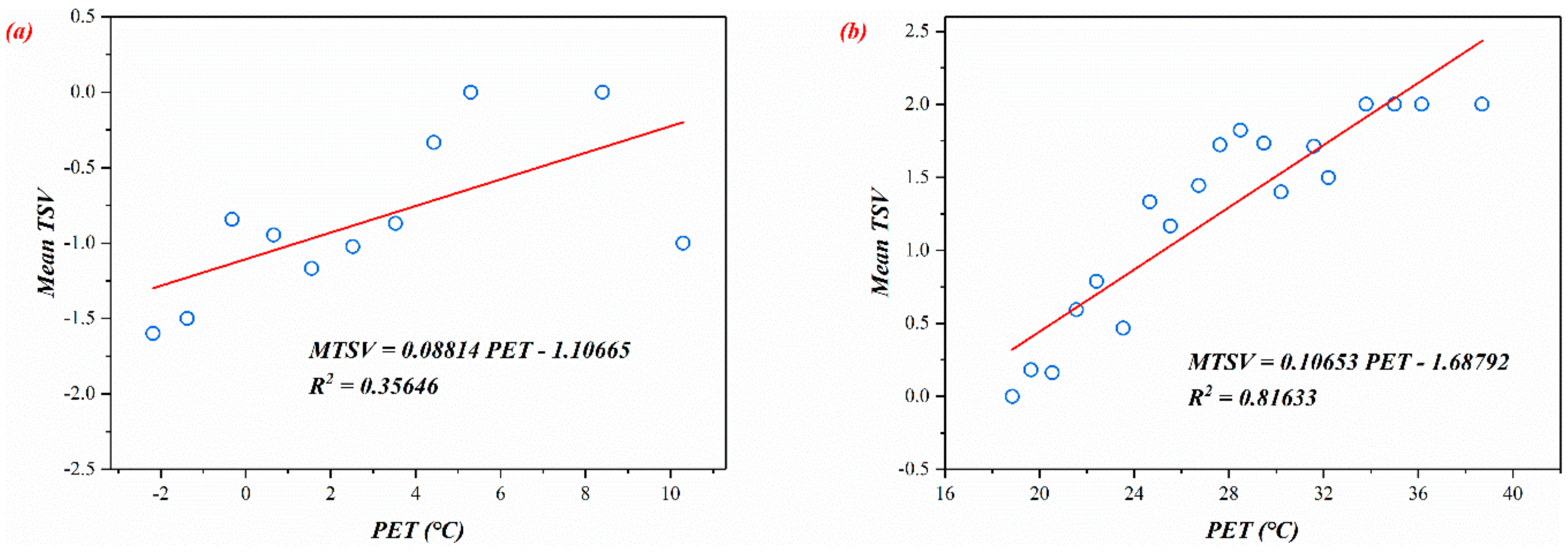
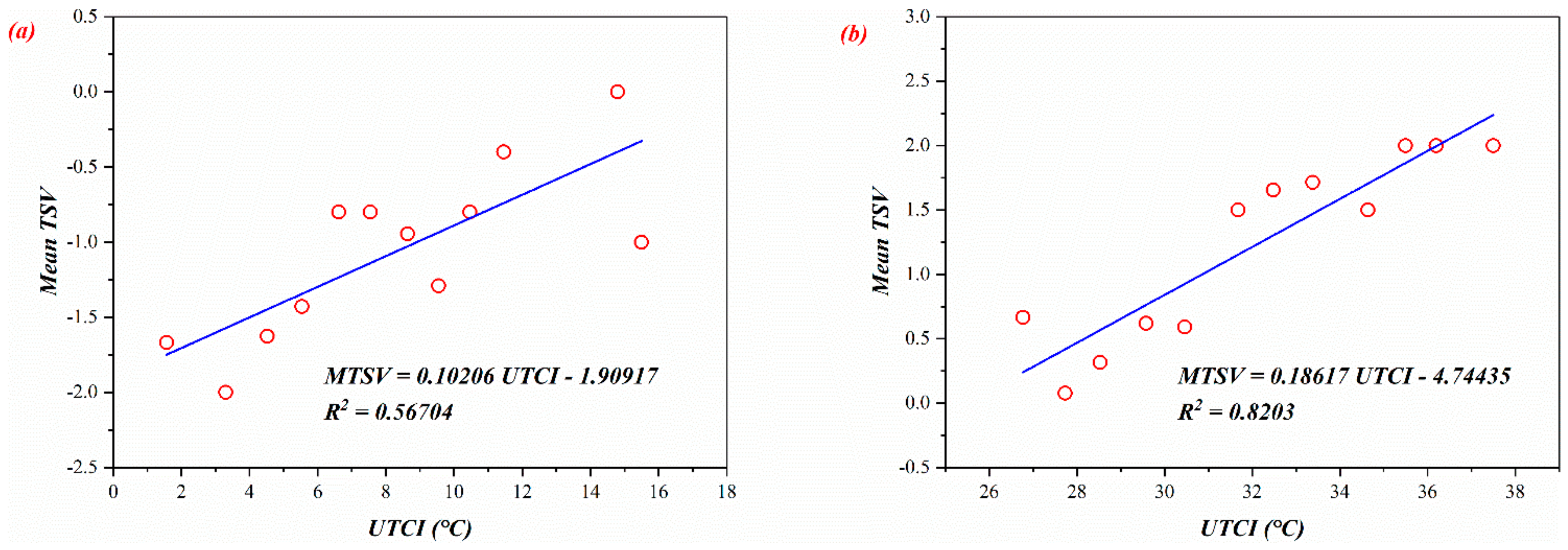
| Authors | City | Climate 1 | Type | Year 2 | Season | Index | Ref. |
|---|---|---|---|---|---|---|---|
| T. Lin, et al. | Taiwan | HSWW | University campus | 2004–2005 | Winter, Summer | SET∗3 | [46] |
| E. Ng, V. Cheng | Hong Kong | HSWW | Urban block | 2006–2007 | Summer, Winter | PET | [47] |
| T. Xi, et al. | Guangzhou | HSWW | University campus | 2010 | July | SET *, MRT 3 | [10] |
| D. Lai, et al. | Wuhan | HSCW | Urban residential community | 2011 | August to November | TSV 3 | [5] |
| X. He, et al. | Beijing | C | Urban block | 2011 | December | PET | [48] |
| J. Huang, et al. | Wuhan | HWCW | Urban residential community | 2011–2014 | All year | UTCI | [49] |
| D. Lai, et al. | Tianjin | C | Urban park | 2012 | All year | UTCI, PET | [11] |
| Y. Zeng, L. Dong | Chengdu | HSCW | Urban block | 2012 | August | Tmrt, PET | [50] |
| W. Liu, et al. | Changsha | HSCW | University campus | 2012–2013 | March 2012 to December 2013 | PET | [51] |
| B. Cao, et al. | Shenzhen | HSWW | Urban block | 2013 | September | TSV | [52] |
| J. Yao, et al. | Shanghai | HSCW | Urban block | 2013–2014 | December 2013 to February 2014 | TSV | [53] |
| L. Zhao, et al. | Guangzhou | HSWW | University campus | 2014 | August to mid-October | SET* | [29] |
| J. Niu, et al. | Hong Kong | HSWW | University campus | 2014 | June | PET | [12] |
| L. Chen, et al. | Shanghai | HSCW | Urban park | 2014–2015 | November 2014 to January 2015 | PET | [41] |
| K. Li, et al. | Guangzhou | HSWW | Urban residential community | 2015 | Winter, Spring, Summer | PET | [28] |
| T. Huang, et al. | Hong Kong | HSWW | University campus | 2016 | Summer, Autumn, Winter | PET, UTCI | [30] |
| J. Li, et al. | Hong Kong | HSWW | University campus | 2016 | March to December | UTCI | [31] |
| Y. Du, et al. | Hong Kong | HSWW | University campus | 2016 | All year | PET | [54] |
| Z. Fang, et al. | Guangzhou | HSWW | University campus | 2016 | All year | PET, UTCI | [36,37,55] |
| X. Chen, et al. | Harbin | SC | University campus | 2016 | All year | PET | [32] |
| X. Ma, et al. | Taizhou | HSCW | Urban block | 2016 | July | PET | [42,56] |
| X. Ma, et al. | Fo Shan | HSWW | Urban block | 2016 | July | PET | [57,58] |
| Y. Wang, et al. | Guangzhou | HSWW | University campus | 2016–2017 | All year | Top 3, PET | [59] |
| S. Yin, et al. | Guangzhou | HSWW | Urban block | 2017 | July | PET | [60] |
| P. Cheung, C.Y. Jim | Hong Kong | HSWW | Urban park | 2017 | All year | PET, UTCI | [35,39,61] |
| C. Shang, et al. | Haikou | HSWW | Holiday beach | 2018 | Spring, Autumn, Winter | PET | [38] |
| B. Cheng, et al. | Mianyang | HSCW | Urban park | 2018 | Summer, Autumn, Winter | PET | [62] |
| M. Xu, et al. | Xi’an | C | Urban park | 2018 | January | PET, UTCI | [33,34] |
| Parameter | Brand and Model | Manufacturer Location | Range | Accuracy | Resolution |
|---|---|---|---|---|---|
| Air temperature | Testo, 174H-Mini Temperature and Humidity Recorder | Schwarzwald, Germany | −20 °C to +70 °C | ±0.5 °C | 0.1 °C |
| Relative humidity | Testo, 174H-Mini Temperature and Humidity Recorder | Schwarzwald, Germany | 0 to 100 % RH | ±3 % | 0.1 % |
| Wind speed | TENMARS, TM-404 Anemometer | Taiwan, China | 0 to 25 m/s | ±2 % | 0.1 m/s |
| Black globe temperature | JT TECHNOLOGY, JTR04 Black Globe Thermometer | Beijing, China | −20 °C to 125 °C | ±0.2 °C | 0.1 °C |
| Global solar radiation | JT TECHNOLOGY, JTR05 Solar Radiometer | Beijing, China | 0 to 2000 W/m2 | ≤±2 % | 1 W/m2 |
| PET (°C) | Thermal Perception | Grade of Physical Stress |
|---|---|---|
| > 41 | Very hot | Extreme heat stress |
| 35 to 41 | Hot | Strong heat stress |
| 29 to 35 | Warm | Moderate heat stress |
| 23 to 29 | Slightly warm | Slight heat stress |
| 18 to 23 | Neutral (Comfortable) | No thermal stress |
| 13 to 18 | Slightly cool | Slight cold stress |
| 8 to 13 | Cool | Moderate cold stress |
| 4 to 8 | Cold | Strong cold stress |
| ≤ 4 | Very cold | Extreme cold stress |
| UTCI (°C) | Thermal Stress Category |
|---|---|
| ≥ +46 | Extreme heat stress |
| +38 to +46 | Very strong heat stress |
| +32 to +38 | Strong heat stress |
| +26 to +32 | Moderate heat stress |
| +9 to +26 | No thermal stress |
| 0 to +9 | Slight cold stress |
| −13 to 0 | Moderate cold stress |
| −27 to −13 | Strong cold stress |
| −40 to −27 | Very strong cold stress |
| <−40 | Extreme cold stress |
| Season | Site | Ta (°C) | RH (%) | v (m/s) | Tg (°C) | G (W/m2) | ||||||||
|---|---|---|---|---|---|---|---|---|---|---|---|---|---|---|
| Mean | Max | Min | Mean | Max | Min | Mean | Max | Min | Mean | Max | Min | Daily Average | ||
| Winter | A | 9.7 | 12.2 | 5.5 | 54.6 | 79.4 | 35.9 | 0.1 | 0.6 | 0.0 | 10.1 | 13.5 | 5.5 | 74 |
| B | 10.3 | 16.2 | 5.3 | 53.2 | 77.0 | 34.2 | 0.3 | 0.8 | 0.0 | 10.5 | 16.4 | 4.8 | 81 | |
| C | 10.1 | 18.1 | 5.2 | 54.1 | 79.0 | 33.4 | 0.2 | 0.6 | 0.0 | 10.5 | 19.4 | 4.7 | 76 | |
| D | 8.5 | 9.8 | 5.2 | 59.4 | 77.4 | 42.9 | 0.1 | 0.4 | 0.0 | 8.7 | 10.1 | 5.3 | 36 | |
| Summer | A | 30.0 | 33.8 | 25.8 | 66.0 | 84.4 | 48.9 | 0.1 | 0.8 | 0.0 | 31.5 | 39.1 | 25.5 | 123 |
| B | 30.4 | 36.7 | 25.7 | 67.6 | 87.3 | 46.8 | 0.2 | 0.9 | 0.0 | 31.2 | 39.2 | 25.2 | 168 | |
| C | 29.6 | 35.7 | 25.2 | 68.4 | 87.5 | 46.5 | 0.1 | 0.4 | 0.0 | 31.0 | 39.5 | 25.6 | 187 | |
| D | 27.3 | 29.4 | 25.0 | 74.9 | 87.9 | 61.8 | 0.1 | 0.2 | 0.0 | 27.4 | 29.4 | 25.1 | 55 | |
| Season | Gender | No. of Persons | Average Age | Average Height (m) | Average Weight (m) | Average Clothing (clo) |
|---|---|---|---|---|---|---|
| Winter | Male | 95 | 45 | 168.3 | 68.9 | 1.52 |
| Female | 104 | 47 | 162.9 | 60.3 | 1.59 | |
| Summer | Male | 98 | 35 | 171.1 | 67.3 | 0.45 |
| Female | 122 | 38 | 164.6 | 59.8 | 0.58 |
| No. | Question | Variable | Option | Statistics and Percentage | |||
|---|---|---|---|---|---|---|---|
| Winter | Summer | ||||||
| 1 | How do you feel at this | TSV | Cold = −3 | 1 | 0.5% | 0 | 0 |
| moment? | Cool = −2 | 68 | 34.2% | 0 | 0 | ||
| Slight cool = −1 | 68 | 34.2% | 0 | 0 | |||
| Neutral = 0 | 56 | 28.1% | 84 | 38.2% | |||
| Slight warm = +1 | 6 | 3% | 75 | 34.1% | |||
| Warm = +2 | 0 | 0 | 61 | 27.7% | |||
| Hot = +3 | 0 | 0 | 0 | 0 | |||
| 2 | How would you prefer the | Ta preference | Higher = +1 | 152 | 76.4% | 0 | 0 |
| air temperature to be? | Unchanged = 0 | 47 | 23.6% | 58 | 26.4% | ||
| Lower = −1 | 0 | 0 | 162 | 73.6% | |||
| 3 | How would you prefer the | RH preference | Damper = +1 | 0 | 0 | 6 | 2.8% |
| relative humidity to be? | Unchanged = 0 | 156 | 78.4% | 195 | 88.6% | ||
| Drier = −1 | 43 | 21.6% | 19 | 8.6% | |||
| 4 | How would you prefer the | Wind preference | Stronger = +1 | 0 | 0 | 191 | 86.8% |
| wind speed to do? | Unchanged = 0 | 121 | 60.8% | 29 | 13.2% | ||
| Weaker = −1 | 78 | 39.2% | 0 | 0 | |||
| 5 | How would you prefer the | Sunshine preference | Stronger = +1 | 162 | 81.4% | 0 | 0 |
| solar radiation to do? | Unchanged = 0 | 36 | 18.1% | 139 | 63.2% | ||
| Weaker = −1 | 1 | 0.5% | 81 | 36.8% | |||
| 6 | Please describe you overall | Thermal comfortable | Uncomfortable = −1 | 58 | 29.1% | 50 | 22.7% |
| comfort level | Neutral = 0 | 138 | 69.4% | 150 | 68.2% | ||
| Comfortable = +1 | 3 | 1.5% | 20 | 9.1% | |||
| 7 | Your acceptable level for current thermal | Thermal acceptability | Absolutely unacceptable = −2 | 3 | 1.5% | 0 | 0 |
| environment? | Unacceptable = -1 | 55 | 27.6% | 63 | 28.6% | ||
| Acceptable = +1 | 141 | 70.9% | 137 | 62.3% | |||
| Absolutely acceptable = +2 | 0 | 0 | 20 | 9.1% | |||
© 2020 by the authors. Licensee MDPI, Basel, Switzerland. This article is an open access article distributed under the terms and conditions of the Creative Commons Attribution (CC BY) license (http://creativecommons.org/licenses/by/4.0/).
Share and Cite
Zhang, L.; Wei, D.; Hou, Y.; Du, J.; Liu, Z.; Zhang, G.; Shi, L. Outdoor Thermal Comfort of Urban Park—A Case Study. Sustainability 2020, 12, 1961. https://doi.org/10.3390/su12051961
Zhang L, Wei D, Hou Y, Du J, Liu Z, Zhang G, Shi L. Outdoor Thermal Comfort of Urban Park—A Case Study. Sustainability. 2020; 12(5):1961. https://doi.org/10.3390/su12051961
Chicago/Turabian StyleZhang, Lili, Dong Wei, Yuyao Hou, Junfei Du, Zu’an Liu, Guomin Zhang, and Long Shi. 2020. "Outdoor Thermal Comfort of Urban Park—A Case Study" Sustainability 12, no. 5: 1961. https://doi.org/10.3390/su12051961





